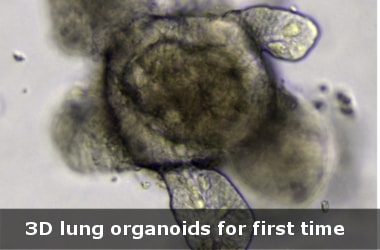3D lung organoids for first time
Q. For the first time, 2D lung organoids have been grown to study which disease?- Published on 19 Sep 16a. Idiopathic pulmonary fibrosis
b. Chronic obstructive pulmonary disease
c. Lung Diseases
d. All of the above
ANSWER: All of the above

A team of researchers have discovered 3D lung organoids or lab grown lung like tissue to study lung diseases like COPD and Idiopathic pulmonary fibrosis.
- The 3D dimensional drug has been created by coating tiny gel beads with lung-derived stem cells and allowing them to self-assemble into the shape of air sacs found in human lungs.
- "While we haven't built a fully functional lung, we have been able to take lung cells and place them in the correct geometrical spacing and pattern to mimic a human lung,” say the researchers
- Idiopathic pulmonary fibrosis is a chronic lung disease caused by scarring of the lungs making them thick and stiff and resulting in breathlessness
- When scientists take cells from people with this disorder and grow them on flat culture, the cells actually appear healthy!
- Inside each well of the organoid, the lung cells grew around the beads, which linked them and formed an evenly distributed three-dimensional pattern.
- To show that these tiny organoids mimicked the structure of actual lungs, the researchers compared the lab-grown tissues with real sections of human lung.
- Moreover, when the researchers added certain molecular factors to the 3D cultures, the lungs developed scars similar to those seen in the lungs of people who have idiopathic pulmonary fibrosis - something that could not be accomplished using 2D cultures of these cells.